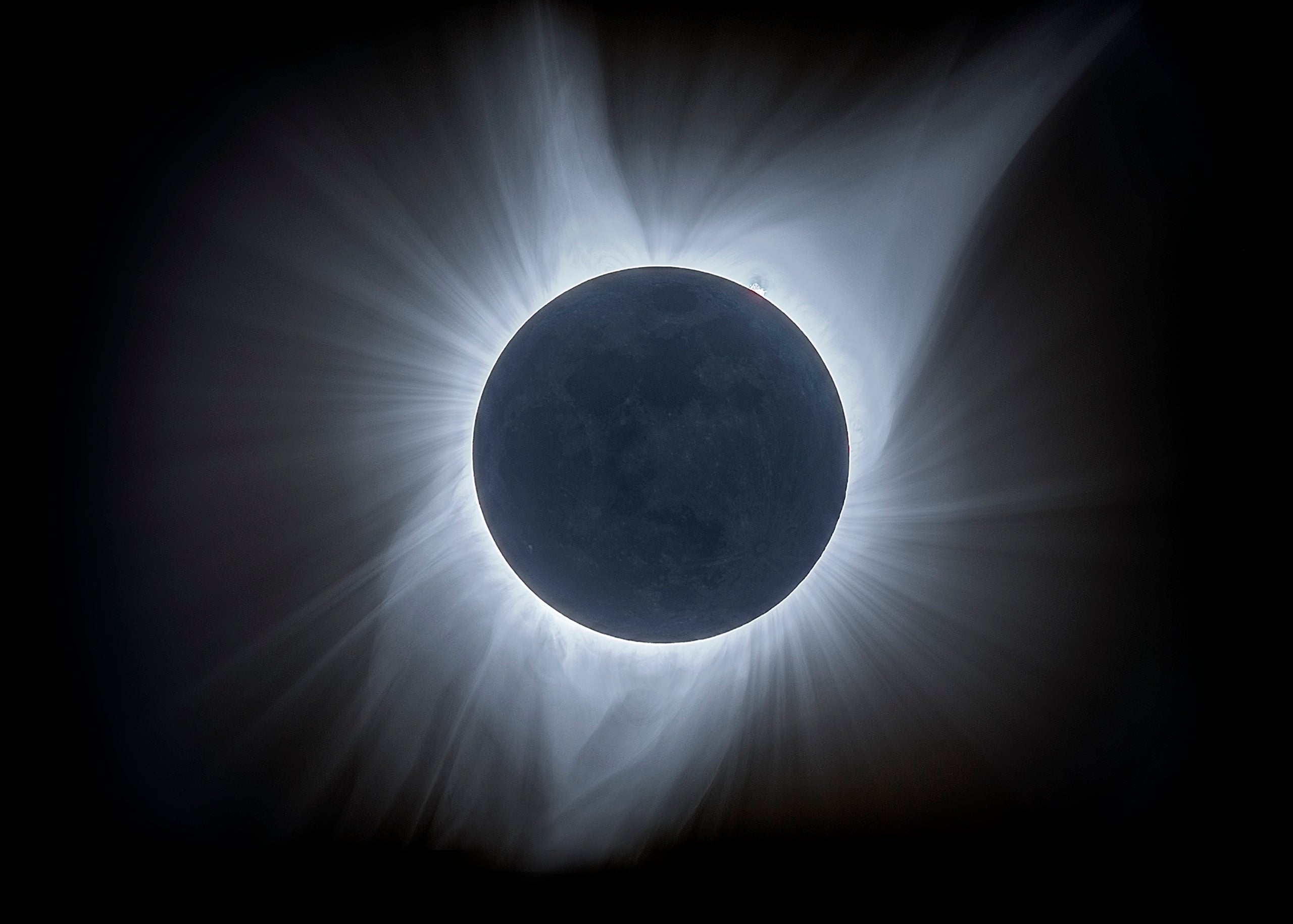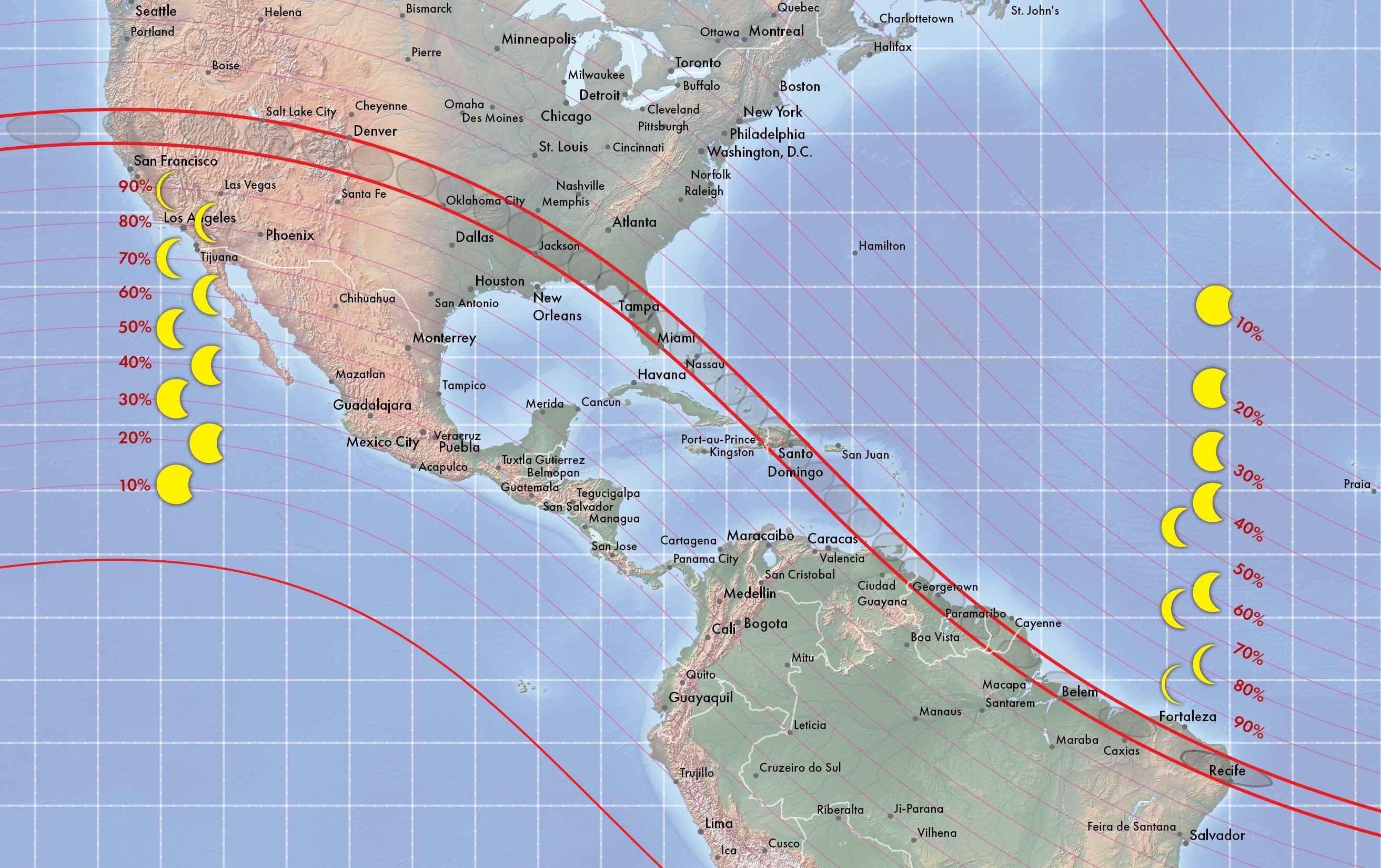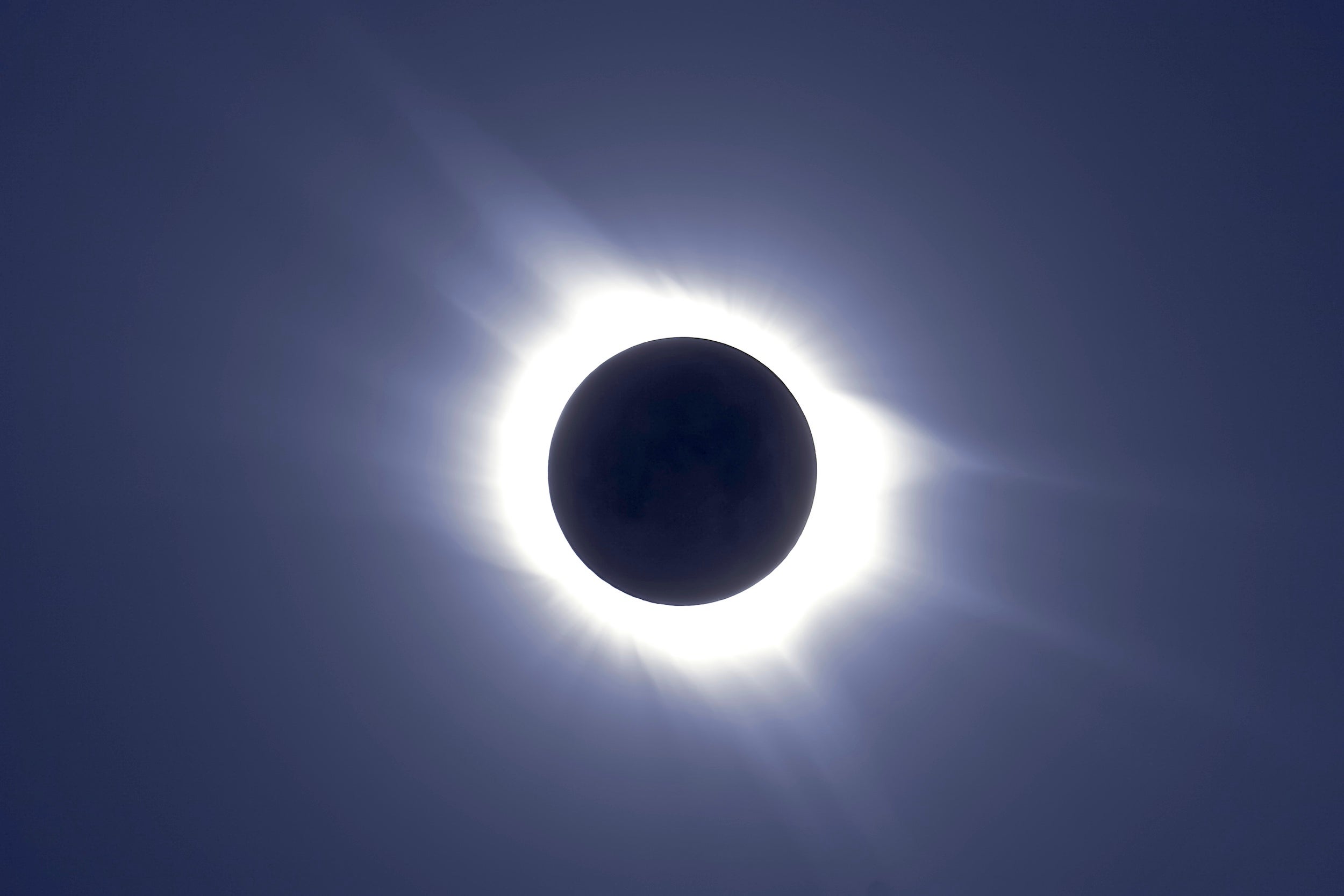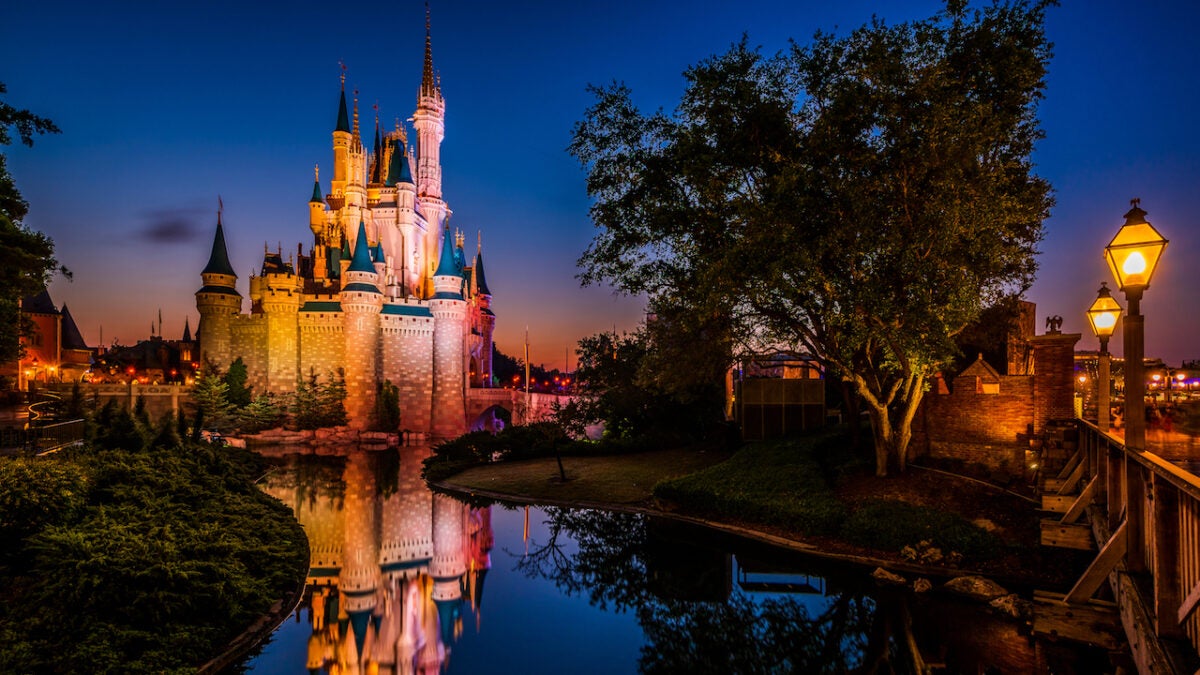
The total solar eclipse set to occur August 12, 2045, will dazzle everyone who views it. And with a maximum duration of totality above 6 minutes, it will be well worth the effort to travel to where conditions are best. However, potential observers might have some questions.
Where exactly in the U.S. will totality be visible? That’s easy to answer with a detailed map, such as the one below. But which locations are the best spots to view the event? That answer is less straightforward.
You’ll surely want to set up shop near the centerline of the eclipse, where totality will last the longest. But what else makes for a good viewing site for a total solar eclipse? What follows are 20 great locations you should consider for the 2045 Great American Eclipse, starting in California and working eastward toward Florida.
I’ll also offer one other suggestion: Carefully consider population. All things being equal, a town of 10,000 is much more likely to have event-related problems than a city of 75,000. Traffic will be one of the primary issues; small communities with one main road may suffer hours of gridlock. If you opt to travel to such a location, get there early — perhaps even a day or two ahead of the eclipse. (Note: August 12, 2045, is a Saturday, so most people will be free during the entire weekend.)
Drive safely and don’t forget your eclipse glasses. I wish you all clear skies!

1. The Pacific Coast of California
If you want to be the first to experience totality in the U.S., be on the water line at the original location of the Cape Mendocino Lighthouse just southwest of Capetown, California. The Moon’s umbra touches the coast there at 9:13 a.m. Pacific Daylight Time. If it’s too difficult to get to that spot, take Mattole Road south less than a mile to Black Sand Beach. Totality lasts the same in both locations.
Eclipse starts: 8:13 a.m. PDT
Eclipse ends: 10:25 a.m. PDT
Maximum eclipse: 9:15:57 a.m. PDT
Sun’s altitude at maximum eclipse: 30.9°
Duration of totality: 4 minutes 22 seconds
Width of Moon’s shadow: 142.1 miles (228.7 km)
2. Cottonwood, California
Those who worry about travel on back roads might consider the small town of Cottonwood, a picturesque location Hollywood has used in several movies. From Sacramento, it’s a 2-hour drive north on Interstate 5, which has an exit for the town. Because Cottonwood has only about 6,000 residents, accommodations will be hard to come by, so it may be a place you’ll just want to travel to for the morning eclipse.
Eclipse starts: 8:14 a.m. PDT
Eclipse end: 10:28 a.m. PDT
Maximum eclipse: 9:17:51 a.m. PDT
Sun’s altitude at maximum eclipse: 32.9°
Duration of totality: 4 minutes 26 seconds
Width of Moon’s shadow: 142.9 miles (230.1 km)
3. Pyramid Lake, Nevada
Are you in or close to northwestern Nevada and looking for somewhere unusual from which to view totality? Look no further than Wizards Beach, which lies on the west side of Pyramid Lake. This location lies roughly 40 miles (64 km) north-northeast of Reno. Note: You won’t be able to get to the northern or eastern sides of the lake because those locations lie within restricted areas of the Pyramid Lake Paiute Tribe Reservation. To simply access Wizards Beach, you’ll need a day pass.
Eclipse starts: 8:15 a.m. PDT
Eclipse end: 10:31 a.m. PDT
Maximum eclipse: 9:20:18 a.m. PDT
Sun’s altitude at maximum eclipse: 35.5°
Duration of totality: 4 minutes 26 seconds
Width of Moon’s shadow: 143.9 miles (231.5 km)
4. Nephi, Utah
If you’ll be in Utah for the eclipse, consider the town of Nephi. Not only does it feature nearly 5 minutes of totality, it lies along a major highway, Interstate 15. Hotel space may be tough to come by, but Provo lies just 40 miles (64 km) north along I-15, and Salt Lake City is 84 miles (135 km) to the north.
Eclipse starts: 9:20 a.m. MDT
Eclipse end: 11:44 a.m. MDT
Maximum eclipse: 10:29:23 a.m. MDT
Sun’s altitude at maximum eclipse: 43°
Duration of totality: 4 minutes 56 seconds
Width of Moon’s shadow: 147 miles (236.6 km)

5. James M. Robb — Colorado River State Park
In western Colorado, the James M. Robb — Colorado River State Park offers a picturesque location from which to view the eclipse. Access from Interstate 70 is immediate, and you’ll enjoy more than 5 minutes of totality. If you’ll be staying in the area, camping might be the best bet because the nearest town, Palisade, isn’t very large.
Eclipse starts: 9:24 a.m. MDT
Eclipse end: 11:50 a.m. MDT
Maximum eclipse: 10:34:08 a.m. MDT
Sun’s altitude at maximum eclipse: 46.6°
Duration of totality: 5 minutes 5 seconds
Width of Moon’s shadow: 148.4 miles (238.8 km)
6. Colorado Springs, Colorado
Would you like to see the eclipse and also explore Pikes Peak from the same location? If so, head to Colorado Springs. It features lots of accommodations, easy access, and a worthy duration of totality. Sensitive individuals may want to get there a day or two early to acclimate to the 6,035-feet (1,839 meters) elevation. Do note, however, that totality lasts more than 10 seconds longer from the southern part of the city than the northern. The numbers given reflect this.
Eclipse starts: 9:27 a.m. MDT
Eclipse ends: 11:56 a.m. MDT
Maximum eclipse: 10:39:18 a.m. MDT
Sun’s altitude at maximum eclipse: 50.1°
Duration of totality: 5 minutes 11 seconds
Width of Moon’s shadow: 149.8 miles (241 km)
7. Greensburg, Kansas
Astronomy buffs might enjoy seeing a 1,000-pound (454 kg) pallasite meteorite, one of the largest on Earth. It’s an exhibit in the Big Well Museum in Greensburg. The name refers to the fact that the town boasts the world’s largest hand-dug well. Oh, and there’s the eclipse, too. But true eclipse chasers will head south out of Greensburg on U.S. Route 183 some 33 miles (53 km) for an additional 34 seconds of totality. It’ll be definitely worth the drive!
Eclipse starts: 10:34 a.m. CDT
Eclipse ends: 12:07 p.m. CDT
Maximum eclipse: 11:48:2753 a.m. CDT
Sun’s altitude at maximum eclipse: 56°
Duration of totality: 4 minutes 58 seconds
Width of Moon’s shadow: 151.9 miles (244.5 km)
Related: Best places to see the next 20 years of eclipses | Eclipse glossary
8. Tulsa, Oklahoma
If it’s clear on eclipse day, Tulsa — Oklahoma’s second-largest city — will be swarming with visitors and excitement. It offers lots of hotel rooms, easy access via Interstate 44, and a superb length of totality. The city is also the home of Western history, performing arts, a long tradition of country and blues music, and great food.
Eclipse starts: 10:38 a.m. CDT
Eclipse ends: 1:14 p.m. CDT
Maximum eclipse: 11:54:59 p.m. CDT
Sun’s altitude at maximum eclipse: 60°
Duration of totality: 5 minutes 39 seconds
Width of Moon’s shadow: 153.1 miles (246.3 km)
9. Pine Bluff, Arkansas
In Arkansas, one of the best locations will be Pine Bluff. It lies along the centerline and is a 45-minute drive from Little Rock — where many eclipse chasers will base — south along Interstate 635. Of course, you could stay right at your hotel in Little Rock if you’re willing to give up 10 seconds of totality. Considering the potential traffic on eclipse day, that might be a fair trade.
Eclipse starts: 10:45 a.m. CDT
Eclipse ends: 1:24 p.m. CDT
Maximum eclipse: 12:03:50 p.m. CDT
Sun’s altitude at maximum eclipse: 65°
Duration of totality: 5 minutes 49 seconds
Width of Moon’s shadow: 154.5 miles (248.6 km)
10. West, Mississippi
Despite its name, West is closer to the center of the state than its western border. This isn’t a large town, with a population under 200, but that number will surely swell on eclipse day because Interstate 55 offers easy access to travelers and because of nearly 6 minutes of darkness. Get there early.
Eclipse starts: 10:50 a.m. CDT
Eclipse ends: 1:29 p.m. CDT
Maximum eclipse: 12:09:04 p.m. CDT
Sun’s altitude at maximum eclipse: 67.7°
Duration of totality: 5 minutes, 54 seconds
Width of Moon’s shadow: 155.2 miles (249.8 km)
11. Meridian, Mississippi
Although Mississippi’s state capital, Jackson, is within the path of totality, it offers only 2 minutes 50 seconds of daytime darkness. A better plan would be to head east 93 miles (150 km) along Interstate 20 to Meridian. With a duration of totality approaching 6 minutes, the city will surely have some type of eclipse festival. And eclipsophiles who want the most for their money can continue along I-20 another 30 miles to York, Alabama, where they’ll enjoy an additional 10 seconds of darkness.
Eclipse starts: 10:51 p.m. CDT
Eclipse ends: 1:33 p.m. CDT
Maximum eclipse: 12:12:05 p.m. CDT
Sun’s altitude at maximum eclipse: 69.2°
Duration of totality: 5 minutes 47 seconds
Width of Moon’s shadow: 250.4 miles (155.6 km)
12. Camden, Alabama
With a population of 2,000, Camden probably will offer some activities on eclipse day. It’s served only by state highways, so be sure to get an early start. One way to access the town is to drive 45 miles (72 km) west from Greenville along Interstate 65.
Eclipse starts: 10:55 a.m. CDT
Eclipse ends: 1:36 p.m. CDT
Maximum eclipse: 12:15:12 p.m. CDT
Sun’s altitude at maximum eclipse: 70.5°
Duration of totality: 5 minutes 58 seconds
Width of Moon’s shadow: 156 miles (251 km)
13. Georgiana, Alabama
Another Alabama town with a population near 2,000 is Georgiana. As you might imagine, hotel rooms will be at a premium. Many eclipse travelers will base in Montgomery. From there, drive south 58 miles (93 km) south along Interstate 65. If you’re staying in Mobile, head northeast 110 miles (180 km), also along I-65.
Eclipse starts: 10:56 a.m. CDT
Eclipse ends: 1:37 p.m. CDT
Maximum eclipse: 12:16:42 p.m. CDT
Sun’s altitude at maximum eclipse: 71.2°
Duration of totality: 5 minutes 59 seconds
Width of Moon’s shadow: 156.3 miles (251.5 km)
14. Straughn, Alabama
This unincorporated community is the first reachable place in the U.S. where you can experience 6 minutes of totality. Specifically, that location gets 5 minutes 59.9 seconds of darkness, but it’s an easy round-up. There, you’ll find a few schools, a few churches, and little else. Get there early.
Eclipse starts: 10:57 a.m. EDT
Eclipse ends: 1:38 p.m. EDT
Maximum eclipse: 12:17:39 p.m. EDT
Sun’s altitude at maximum eclipse: 71.7°
Duration of totality: 6 minutes
Width of Moon’s shadow: 156.4 miles (251.6 km)
15. Shell Point Beach, Florida
This location is part of the unincorporated community of Shell Point. It’s the last spot of land the centerline crosses before it heads across the waters of Apalachee Bay (and the Gulf of Mexico to once again encounter Florida). The beach is managed by the county Department of Parks and Recreation, so you might find some activities there on eclipse day. At the least, you can take a relaxing dip in the bay after totality.
Eclipse starts: 12:02 p.m. EDT
Eclipse ends: 2:44 p.m. EDT
Maximum eclipse: 1:23:35 p.m. EDT
Sun’s altitude at maximum eclipse: 74°
Duration of totality: 6 minutes 2 seconds
Width of Moon’s shadow: 157 miles (252.7 km)
16. Suwannee, Florida
OK, if I’m being honest, I chose this location because of my fondness for the George Gershwin/Irving Caeser song “Swanee,” popularized by Al Jolson. It is a great location, though. This unincorporated community of about 300 residents is mainly a fishing village. If you enjoy that activity, you can probably hire a local to take you out for a day. Just not on eclipse day!
Eclipse starts: 12:05 p.m. EDT
Eclipse ends: 2:47 p.m. EDT
Maximum eclipse: 1:26:51 p.m. EDT
Sun’s altitude at maximum eclipse: 75.1°
Duration of totality: 6 minutes 4 seconds
Width of Moon’s shadow: 157.4 miles (253.3 km)
17. Floral City, Florida
This town, because it currently has slightly more than 5,000 residents, might be a place that will host some eclipse-related events. If you’re planning to stay there, however, be sure to book a room a year in advance. Access is easy, just 15 miles (24 km) from Interstate 75 along Florida Highway 48.
Eclipse starts: 12:07 p.m. EDT
Eclipse ends: 2:49 p.m. EDT
Maximum eclipse: 1:29:22 p.m. EDT
Sun’s altitude at maximum eclipse: 75.9°
Duration of totality: 6 minutes 4 seconds
Width of Moon’s shadow: 157.7 miles (253.7 km)
18. Walt Disney World Resort, Florida

Of all the destinations along the path of the 2045 eclipse, this one surely will prove to be the most epic. I do wonder how they’ll handle logistics. Will they stop all the rides at some point before totality? No offense, but I don’t want to be inside with the Pirates of the Caribbean when the great celestial lineup is happening outside. It will be expensive, I’m sure. But here’s a suggestion: Watch for the earliest date you can buy tickets, grab a dozen, and scalp 10 of them.
Eclipse starts: 12:09 p.m. EDT
Eclipse ends: 2:51 p.m. EDT
Maximum eclipse: 1:31:20 p.m. EDT
Sun’s altitude at maximum eclipse: 76.3°
Duration of totality: 6 minutes 3 seconds
Width of Moon’s shadow: 157.9 miles (254.1 km)
19. Port St. Lucie, Florida
With more than 200,000 residents, this city will be a popular destination for eclipse-watchers. Because Interstate 95 runs through the city, getting there from either Jacksonville (no totality) to the north or Miami (1 minute 58 seconds) to the south will be easy. So, even though Port St. Lucie has lots of rooms to rent, make your reservation as early as you can.
Eclipse starts: 12:13 p.m. EDT
Eclipse ends: 2:55 p.m. EDT
Maximum eclipse: 1:35:26 p.m. EDT
Sun’s altitude at maximum eclipse: 77.2°
Duration of totality: 6 minutes 4 seconds
Width of Moon’s shadow: 158.2 miles (254.6 km)
20. Sailfish Point, Florida
I’m only including this location for people who want to be on land at the last place in the U.S. the eclipse’s centerline will touch. Please note that, as of this writing, it is a private community. But some homeowners might be willing to rent a room the night before the big event and let you set up in their yard (or on their boat) to watch it.
Eclipse starts: 12:13 p.m. EDT
Eclipse ends: 2:56 p.m. EDT
Maximum eclipse: 1:35:58 p.m. EDT
Sun’s altitude at maximum eclipse: 77.3°
Duration of totality: 6 minutes 4 seconds
Width of Moon’s shadow: 158.3 miles (254.7 km)









